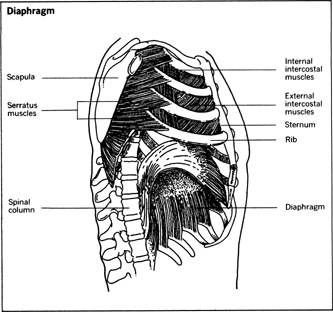The Respiratory System and the Lungs - Our big breathing muscle: the diaphragm
What gets air into and out of our lungs? The answer may seem as obvious as breathing in and out. But except for those rare instances when we consciously regulate our breathing pattern—which physicians call “force breathing"—we do not decide when to inhale and when to exhale. And even when we do force-breathe, it is not primarily the action of opening the mouth and gulping in air, then blowing it out, that gets air down the windpipe and into the alveoli of the lungs. The main work of inhaling and exhaling is done by the contraction and relaxation of the big helmet-shaped muscle on which the lungs rest and which marks the “floor” of the chest or thoracic cavity and the “ceiling” of the abdominal cavity. This muscle is the diaphragm .

It is the diaphragm that causes the lungs to swell and fill with fresh air, then partially collapse to expel used gases. The muscles and tendons of the sinewy diaphragm are attached at the back to the spinal column, at the front to the breastbone ( sternum ), and at the lower sides to the lower ribs.
The diaphragm contracts and relaxes on orders from the brain's breathing center, orders that are carried along the pathways of the autonomic nervous system. When the medulla sends messages to the breathing muscles to contract, the diaphragm is pulled downward, enlarging the space filled by the lungs. This creates a temporary partial vacuum, into which air rushes, inflating and expanding the lungs. When the diaphragm relaxes, the lung space is reduced, pushing air out.
Other Breathing Muscles
The diaphragm muscle's leading role in breathing is supported by several other muscles that play minor parts. Among these are the intercostal muscles between the ribs that give the rib cage a slight push upward and outward, enlarging the thoracic cavity, and the serratus muscles , which are mainly muscular sheaths along the ribs, to which other muscles are attached.

Comment about this article, ask questions, or add new information about this topic: